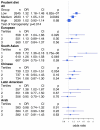The effect of chromosome 9p21 variants on cardiovascular disease may be modified by dietary intake: evidence from a case/control and a prospective study
- PMID: 22022235
- PMCID: PMC3191151
- DOI: 10.1371/journal.pmed.1001106
The effect of chromosome 9p21 variants on cardiovascular disease may be modified by dietary intake: evidence from a case/control and a prospective study
Abstract
Background: One of the most robust genetic associations for cardiovascular disease (CVD) is the Chromosome 9p21 region. However, the interaction of this locus with environmental factors has not been extensively explored. We investigated the association of 9p21 with myocardial infarction (MI) in individuals of different ethnicities, and tested for an interaction with environmental factors.
Methods and findings: We genotyped four 9p21 SNPs in 8,114 individuals from the global INTERHEART study. All four variants were associated with MI, with odds ratios (ORs) of 1.18 to 1.20 (1.85×10(-8)≤p≤5.21×10(-7)). A significant interaction (p = 4.0×10(-4)) was observed between rs2383206 and a factor-analysis-derived "prudent" diet pattern score, for which a major component was raw vegetables. An effect of 9p21 on MI was observed in the group with a low prudent diet score (OR = 1.32, p = 6.82×10(-7)), but the effect was diminished in a step-wise fashion in the medium (OR = 1.17, p = 4.9×10(-3)) and high prudent diet scoring groups (OR = 1.02, p = 0.68) (p = 0.014 for difference). We also analyzed data from 19,129 individuals (including 1,014 incident cases of CVD) from the prospective FINRISK study, which used a closely related dietary variable. In this analysis, the 9p21 risk allele demonstrated a larger effect on CVD risk in the groups with diets low or average for fresh vegetables, fruits, and berries (hazard ratio [HR] = 1.22, p = 3.0×10(-4), and HR = 1.35, p = 4.1×10(-3), respectively) compared to the group with high consumption of these foods (HR = 0.96, p = 0.73) (p = 0.0011 for difference). The combination of the least prudent diet and two copies of the risk allele was associated with a 2-fold increase in risk for MI (OR = 1.98, p = 2.11×10(-9)) in the INTERHEART study and a 1.66-fold increase in risk for CVD in the FINRISK study (HR = 1.66, p = 0.0026).
Conclusions: The risk of MI and CVD conferred by Chromosome 9p21 SNPs appears to be modified by a prudent diet high in raw vegetables and fruits. Please see later in the article for the Editors' Summary.
Conflict of interest statement
The authors have declared that no competing interests exist.
Figures




Comment in
-
The effect of chromosome 9p21 variants on cardiovascular disease may be modified by dietary intake.Circ Cardiovasc Genet. 2012 Feb 1;5(1):148-50. doi: 10.1161/CIRCGENETICS.111.962662. Circ Cardiovasc Genet. 2012. PMID: 22337928 No abstract available.
References
-
- Murray CJ, Lopez AD. Alternative projections of mortality and disability by cause 1990–2020: Global Burden of Disease Study. Lancet. 1997;349:1498–1504. - PubMed
-
- Yusuf S, Hawken S, Ounpuu S, Dans T, Avezum A, et al. Effect of potentially modifiable risk factors associated with myocardial infarction in 52 countries (the INTERHEART study): case-control study. Lancet. 2004;364:937–952. - PubMed
-
- Marenberg ME, Risch N, Berkman LF, Floderus B, de Faire U. Genetic susceptibility to death from coronary heart disease in a study of twins. N Engl J Med. 1994;330:1041–1046. - PubMed
-
- Shea S, Ottman R, Gabrieli C, Stein Z, Nichols A. Family history as an independent risk factor for coronary artery disease. J Am Coll Cardiol. 1984;4:793–801. - PubMed
Publication types
MeSH terms
LinkOut - more resources
Full Text Sources
Medical
Miscellaneous

